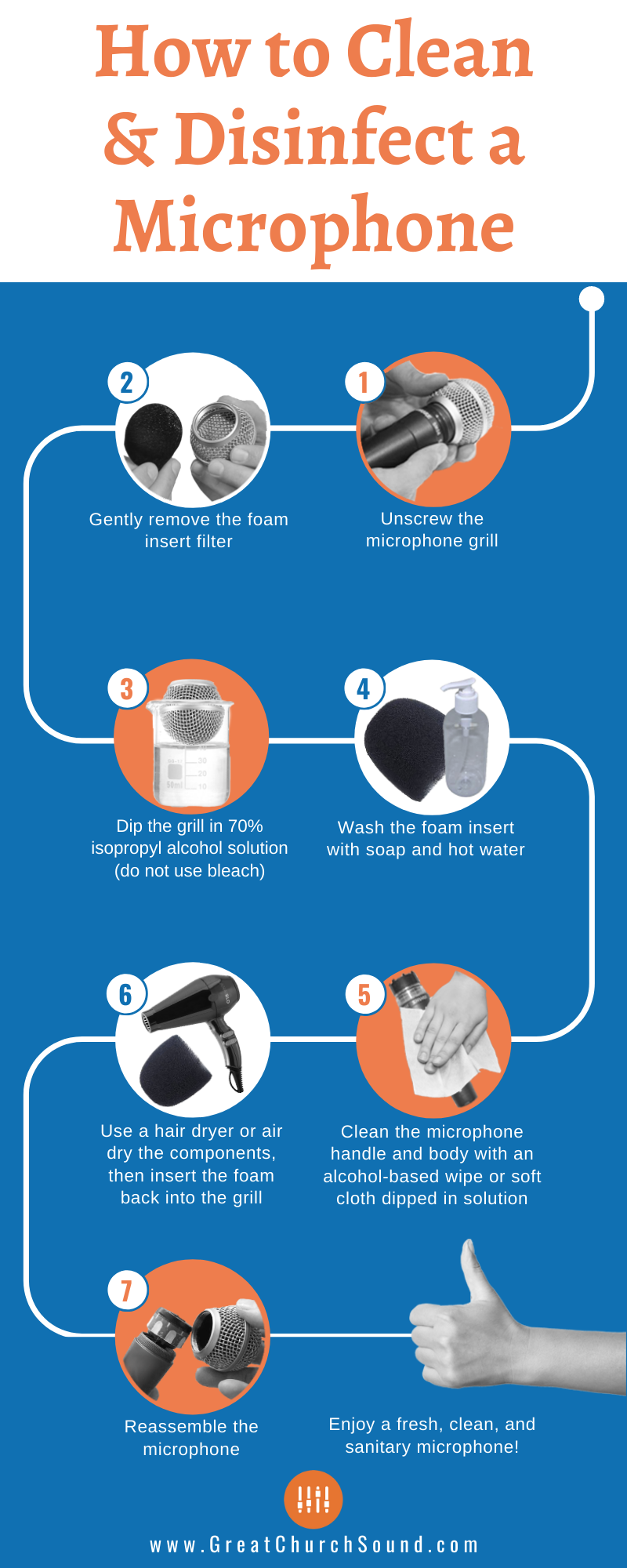How To Clean & Disinfect a Microphone

With cold and flu (and now Coronavirus / COVID-19) season here in force, there have been a lot of questions about how to properly clean and disinfect microphones.
Unsurprisingly, there is some misleading and often bad information on some of the social media threads that I’ve seen lately.
Here are some tips to help you keep those mics clean and sanitary, now and any time of year.
Why should I clean a microphone?
The recommended mic placement for handheld vocal microphones means that the microphone is very close to or even touches the singer’s face or lips. This means that spit/mucus/etc. can easily be transferred from the mouth to the microphone grill and underlying foam filter.
The body of the microphone is another surface that can be contaminated by contact with the hands.
If you don’t have a dedicated microphone for each vocalist or pastor on your team, then you may want to consider some of the following health and sanitary recommendations.
Here is how to properly clean and disinfect a handheld microphone:
Follow these steps to clean your microphones and have them ready for the next user.
Step 1
- Most handheld microphones have a removable metal grill. Unscrew the grill from the microphone.
Step 2
- Remove the foam insert that is inside the grill.
Step 3
- Spray or dip the entire metal grill in a solution of 70% isopropyl alcohol. Use a brush to clean any grit, lipstick, etc. from the grill.
Step 4
- Wash the foam insert with soap and hot water.
Step 5
- Wipe down the body of the microphone with a disinfecting wipe or a solution of alcohol on a cloth rag.
Step 6
- Dry the washed components. Use a hair dryer on low heat or allow to air dry.
Step 7
- Reassemble the components.

Avoid these things when cleaning your microphones:
- DO NOT use bleach to wipe down or submerge any hardware. This can damage metal and other finishes. A 70% isopropyl alcohol (IPA) mixture or soap and hot water is preferred.
- DO NOT spray liquid on or near the microphone capsule or electronics.
- Mouthwash (like Listerine and others) does not have sufficient alcohol content to kill viruses. While it can leave your mics smelling minty fresh, it should not be relied on as a disinfectant.
Other Sanitary Tips
Even if you have a dedicated microphone for each singer or pastor, the mics are often co-mingled in the same storage location after services. For this reason, it may be best to keep microphones separated after use.
I also like to label or color code microphones that are dedicated to specific people.
And don’t forget about those foam pop filters on the ends of lavaliere and headset mics. Anything that can attract spit or can be placed close to the mouth should be a candidate for disinfecting.
Oh, and wash your hands!
PRO TIP: While you're cleaning microphones, it might not be a bad idea to wipe down all those faders and knobs on the mixing console. A soft bristle tooth brush can work great for gently scrubbing mic grills and faders pads.
Products for Mic Cleaning
The following products are available on Amazon or other online stores and can be helpful in cleaning and disinfecting your microphones.
- 70% isopropyl alcohol is a great disinfectant
- Dish soap and hand soap can be used for many cleaning purposes
- Alcohol-based sanitary wipes are convenient and effective for cleaning many surfaces
- Microphome and Goby Labs cleaning sprays are made for microphone cleaning
- UV-C lights can effectively disinfect a variety of electronic hardware and surfaces
- Antimicrobial microphone covers add an extra layer of germ protection
- Replacement microphone grills and foam inserts keep your mics looking like new
The Science of Disinfectants
Did you know that 70% isopropyl alcohol (IPA) is more effective at disinfecting than 91-100% alcohol solutions?
It’s true.
Alcohol solutions greater than 91% can still kill bacteria and germs, but they take longer to be effective than 62-70% isopropyl alcohol solutions. This is because the higher percentage solutions take longer to penetrate the cell walls and kill microorganisms. This is why 62-70% isopropyl alcohol products are recommended for disinfectant use over higher percentage alcohol mixture options.
And did you know that regular hand soap is more effective at destroying (or neutralizing) a virus than hand sanitizer?
Yup, that’s true as well.
Soap works better at breaking down the fatty parts (lipids) of a cell and allows the cell wall to fall apart.
Disclaimer
I am not a healthcare professional and the information provided here is not medical advice.
Stay safe and healthy out there!
Resources
Download this step-by-step chart and keep it in your tech room for easy reference next time you need to clean your microphones.
Please note that some of the links and discount codes included throughout this website are affiliate links and Great Church Sound and/or James Wasem will earn a commission if you decide to make a purchase. This is at no additional cost to you.
These are tools I personally have used or recommend because they are helpful and useful, not because of the commissions made if you decide to buy something.
Affiliate earnings and commissions help keep this site active and populated with fresh content. If you decide to purchase something through these links, I would like to say Thank You!





